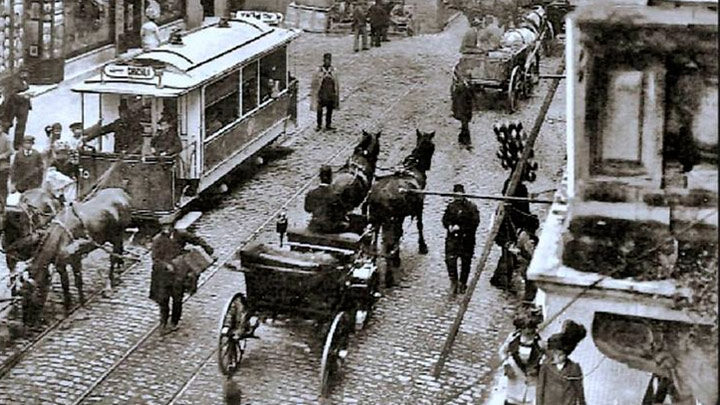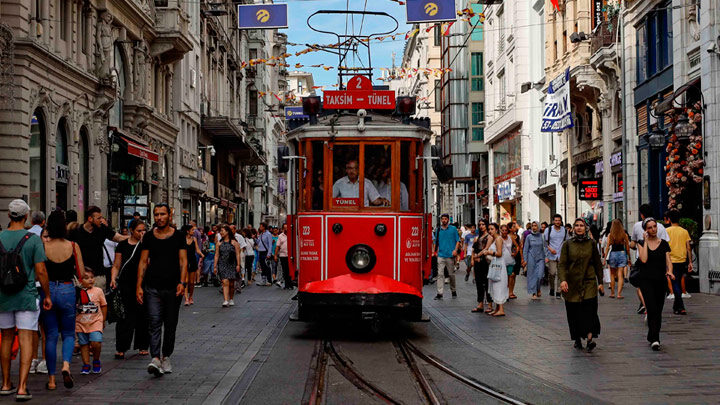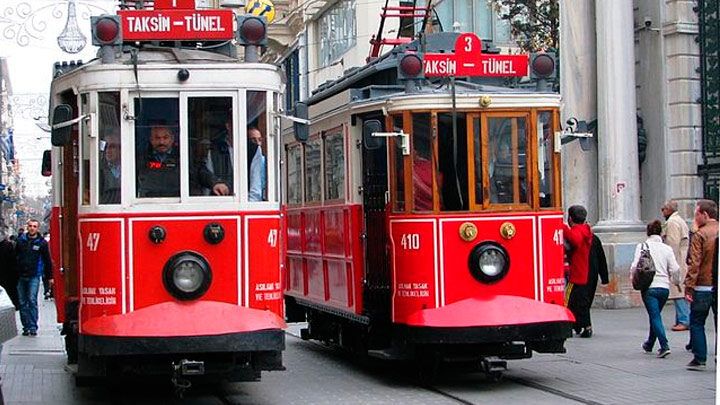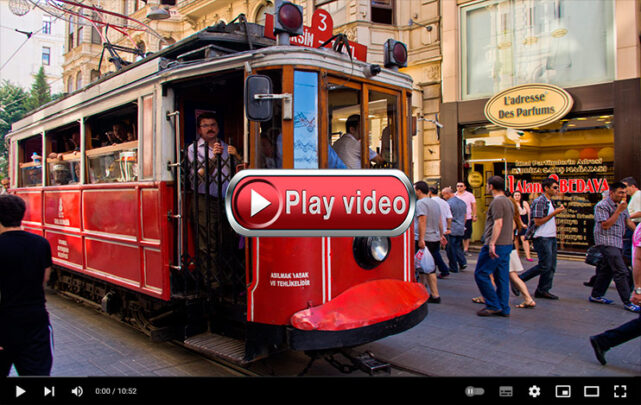Hits: 9
ENGLISH | DEUTSCH | FRANÇAIS | TÜRKÇE
Istanbul inaugurated horse tramway in 1872 and these served the people of Istanbul until 1912. Following this date, electric trams were put in place and they were the main means for urban public transport until 1966.

Many additional tramlines were added over time, and the system reached its greatest extent in 1956 with 108 million passengers carried by 270 tram-cars on 56 tramway lines. But starting from the mid-1950s, automobile traffic congestion in Istanbul increased rapidly. Bus and taxi services grew rapidly over the same period of time. The number of private cars also increased greatly, and many narrow streets, which were ideal for trams, now started filling up with motor vehicles.
History
Tramcars were not modernized for many decades, and some of the 1911 electric cars were still running in the 1960s. At that time, modern buses provided faster and smoother journeys, whereas the trams were slower, narrow single-coach cars and had many outdated features like bow collectors. Poor maintenance of tracks caused derailments and bumpy rides. Due to the city‘s rapid growth, reconstruction of Istanbul‘s infrastructure became urgent, and many streets were widened.
The transport authority thought that slow tram transport sharing road space with fast bus transport would cause many problems in trying to guarantee smoother city transportation. In sum, the tramway had little comfort and was slow because it was caught in the traffic jam caused by the cars, and the tracks were also outdated, noisy and in the middle of the street. Cars had to pass the tramway on the right, causing danger for the pedestrians boarding and alighting the tramway.
After closing the tram network in mid-1960s, it was believed that by removing the old-fashioned obstacle to smooth city traveling, the city would be able to move faster than before, but this belief was proven to be false in the following years. The uncontrolled increase in petrol-based vehicles like buses, taxis, and private cars began to choke the streets of Istanbul.
For being situated mostly in Asia, Turkey suffered by many problems common to developing countries, including pollution, traffic jams, illegal migration, low literacy and increasing population, etc. Increasing population led to the increasing urbanization of Istanbul, which spawned increasing motor vehicles, increasing air and noise pollution, and increasing traffic jams and smog.
New era
The city eventually became slower than pre-tram closure era. From 1970 onwards, all this problems grew rapidly, and by the mid-1980s Istanbulians realized that the failure to control motor vehicles, and the closure of tram network, was a great mistake. Many cities around the world like Tunis, Buenos Aires, etc., also realized this error and, like them, Istanbul also planned for the return of the tram.

As an experiment, Istanbul first opened a heritage tramline at European side in 1990. Due to its increasing popularity, a modern tramline was opened in 1992, also at European side. Another heritage tramline opened in 2003, but this time on the Asian side, and another modern tramline opened in 2007.
Historic tram on Istiklal Street
This is Istanbul city transport, route number T2. But for tourists, this is a special type of transport – a historical tram or Nostalgic Tram. Despite the more than a century-old history of tram lines in Istanbul, which began in the XIX century with carriages driven by horses, in fact, this line is conditionally historical.
Trams here began to run in 1871, but in the middle of the last century were removed. The line was reopened only in 1990 after almost forty years of downtime, and especially for it created stylized antique beautiful red trams, reminiscent of those that walked around the city in the middle of the last century.
The T2 Line stretches from Taksim Square through Istiklal tourist street for a distance of just under one and a half kilometers, making 3 stops along the way. But you are unlikely to move on it in order to get from place to place, it will be faster on foot. But you can ride a retro tram, which has long become one of the tourist symbols of the city, with pleasure, if, of course, you can get into it.

The fact is that the tram does not run often and very slowly, because it has to break through the crowds of onlookers-tourists, carefree walking along Istiklal Street right on the rails. In addition, in the high tourist season (spring and autumn) in the afternoon and until late in the evening, it is packed to capacity with those who want to ride, and in order to sit in it, you will have to stand in line at the stop.
And besides, the tram is besieged by local young people who just for the sake of „fun“ ride it outside as „hares“. In the morning it is much easier to drive, but there will not be the same tourist atmosphere as in the evening.
But even if you can not ride, be sure to take a selfie and a few photos of the historic tram.
Working hours
Runs from 07:00 to 22:00 every 40-50 minutes on schedule.
Tickets price
The fare is 4.60 lira (see Turkish currency and exchange rate), payment by Istanbul card.
How to get there
Walks on Istiklal Street the rails are laid right in the middle of the street (Istiklal Street on the map. You can take it at any of the three stops along the route, or at the final ones.
You can take a ride on the historical tram and take walks around the tourist part of Istanbul on your own, but it is more interesting to do this with Group and individual excursions.






[…] English […]
[…] English […]